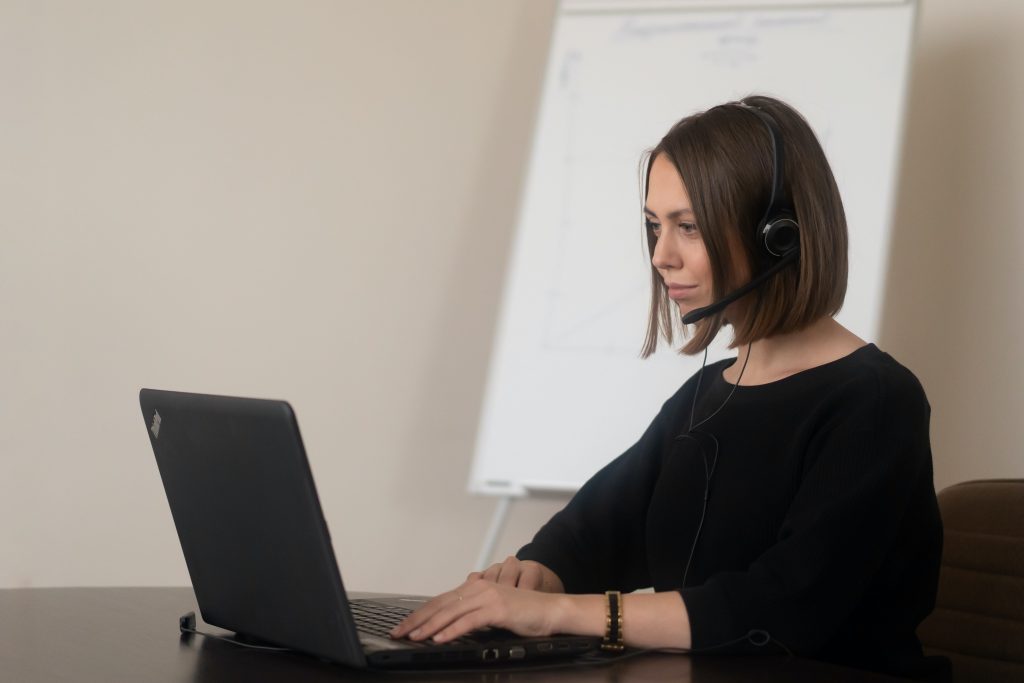
Mary Hernandez Castellanos
Working remotely has been tagged as our “new normal.” But how do we adjust to this new way of providing our services? Well, let me tell you a little of how I’ve organized my office space to have a reliable connection, quality sound, adequate lighting, the ability to handle the different platforms and to communicate with my virtual booth mate. And by office space I mean a small corner in my bedroom. It sounds like a lot, right?
Well, let’s get started! Reliable connection. I made sure to purchase an Ethernet adapter (it depends on the computer laptop model). This ensures that I am always hardwired. There have been times when I accidentally provided services on Wi-Fi! Thank goodness nothing went wrong. I was lucky, I’m sure. I previously used a MacBook Air as my main device; now I use a MacBook Pro. I tell you this because although they are the same brand, I had to purchase different Ethernet adapters.
Now let’s talk about sound. Sound is a critical part of our services; if the client can’t hear us, then our job is null. The moment we were shut down due to the pandemic, I realized I’d be working remotely, so I went into research mode. I asked colleagues what headsets they’d recommend. Some were too expensive for me, so I opted for a less expensive, but reliable option.
The headset has a USB connection adapter, noise canceling microphone and over the ear coverage. I tested the headsets with family and colleagues before my first assignment. The sound was good. I was ready to provide my services remotely.
Lighting is as important. If you don’t need to have your camera on, then not to worry. But if you do, a good source of lighting is essential. I purchased a ring light from Amazon. All of my office setup was done on a budget. So unless you absolutely need to have specific equipment, I suggest saving where you can.
Now that I was ready to work, I also had to know the various platforms that clients were using. I set time aside to test different platforms. I won’t name them all, but the primary one I use is Zoom. With simultaneous interpretation as an add-in, it’s perfect for community meetings, webinars, educational settings, etc.
The only downside to the Zoom platform is that we, the interpreters, can’t communicate with our virtual booth mates. However, my quick solution to that is to have an open phone line to communicate with my partner. We call each other on the phone (to listen to one another) and also have WhatsApp ready to chat and announce our turn. Your choice can be different, but that’s the one that has worked for me.
As previously mentioned, my main platform is Zoom. When using Zoom, I make sure to check for updates, as they update their platform almost weekly. Being assigned as an interpreter on Zoom is easy; the host will assign you to a channel with your language pair. When you get a notification to act as an interpreter, select “ok” and it’s done.
However, if a participant isn’t on a language channel, they will not hear us (the interpreter). I log in with a second device (i.e. phone) to use in participant mode so I can make announcements and remind everyone to select a Language Channel. This second device has the zoom app downloaded with a different email address than the one used as interpreter. It works best this way for me. Once that is settled, it will be a smooth transition for simultaneous interpretation.
To sum up, working remotely can be scary, but also exciting and definitely successful. It can also open the door to many opportunities! With a designated office space, reliable connection, a separate device to communicate with your partner and also a backup device in case your primary one fails, you will no doubt excel in your remote assignments.
 MARY HERNANDEZ CASTELLANOS, is a Spanish/English Community Remote and in-Person Interpreter based in California. She provides services for schools, city council sessions, board meetings, immigration, unions, non-profit organizations, and various community events. She completed her interpreting studies in 2017 at the Southern California School of Interpretation (SCSI) and received a Certificate of Completion as Court Legal Interpreter. While in school, she interned in the offices of Harriet Buhai Family Law, where she realized that her passion was to serve the community through interpretation. At SCSI, she also took the Immigration Interpreting Course and has since earned a CoreCHI provisional certification. Mary is the co-founder of I&T Lounge, Meet*Share*Learn, an online community that holds interpretation practice sessions and shares many tips and tricks on Instagram and YouTube.
MARY HERNANDEZ CASTELLANOS, is a Spanish/English Community Remote and in-Person Interpreter based in California. She provides services for schools, city council sessions, board meetings, immigration, unions, non-profit organizations, and various community events. She completed her interpreting studies in 2017 at the Southern California School of Interpretation (SCSI) and received a Certificate of Completion as Court Legal Interpreter. While in school, she interned in the offices of Harriet Buhai Family Law, where she realized that her passion was to serve the community through interpretation. At SCSI, she also took the Immigration Interpreting Course and has since earned a CoreCHI provisional certification. Mary is the co-founder of I&T Lounge, Meet*Share*Learn, an online community that holds interpretation practice sessions and shares many tips and tricks on Instagram and YouTube.

Leave a Reply